Charles E W Bean, Diaries, AWM38 3DRL 606/249/1 - 1917 - 1932 - Part 4
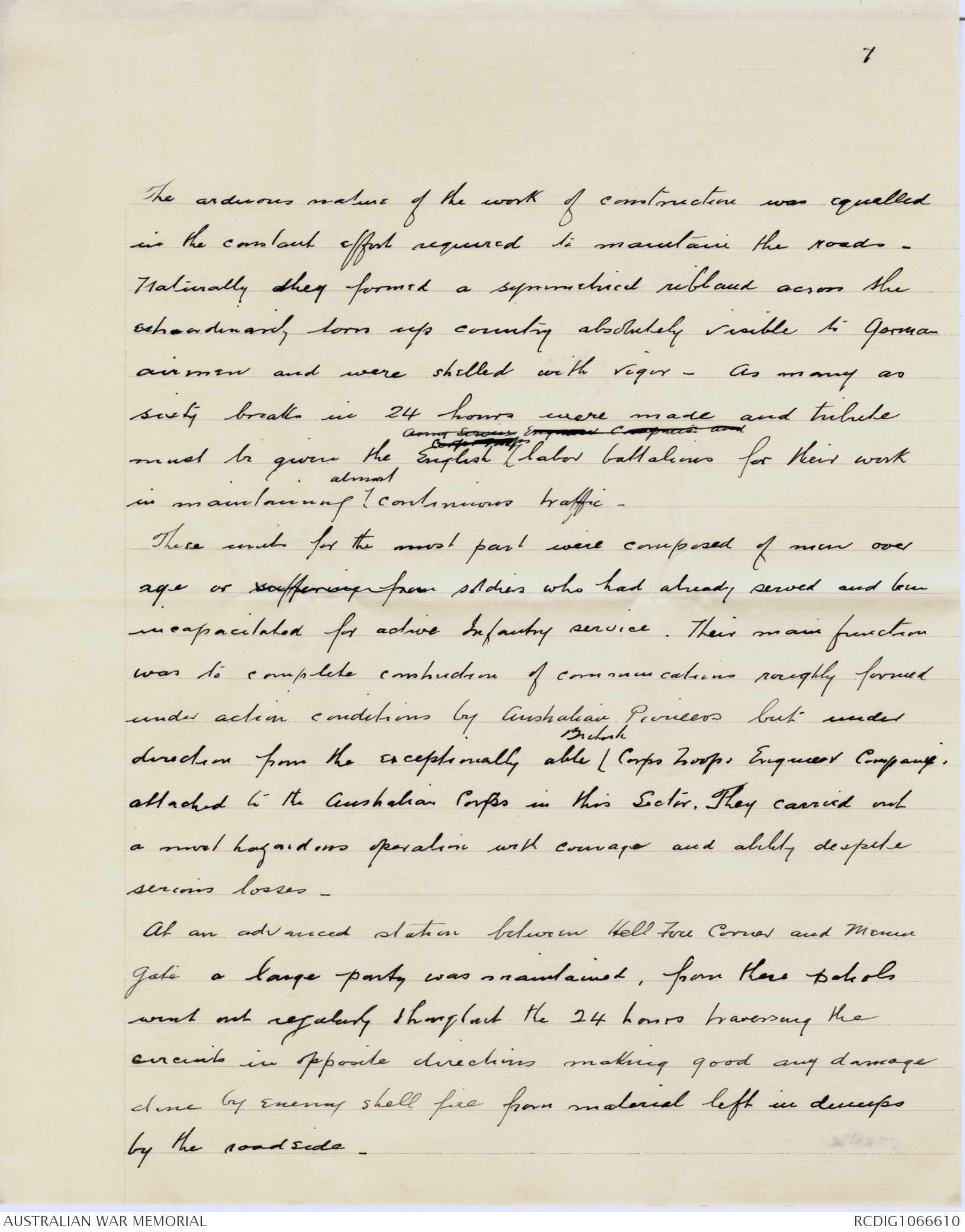
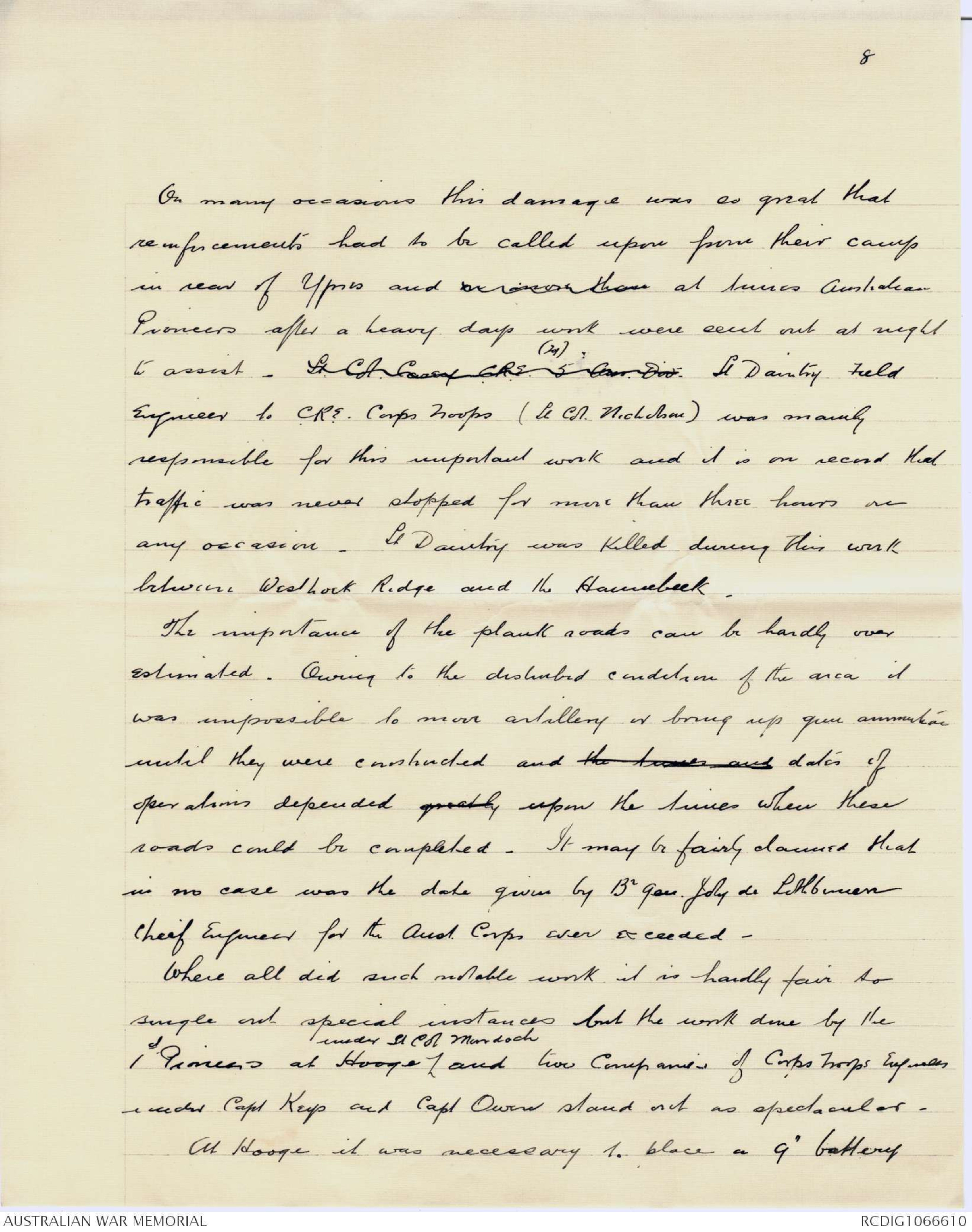
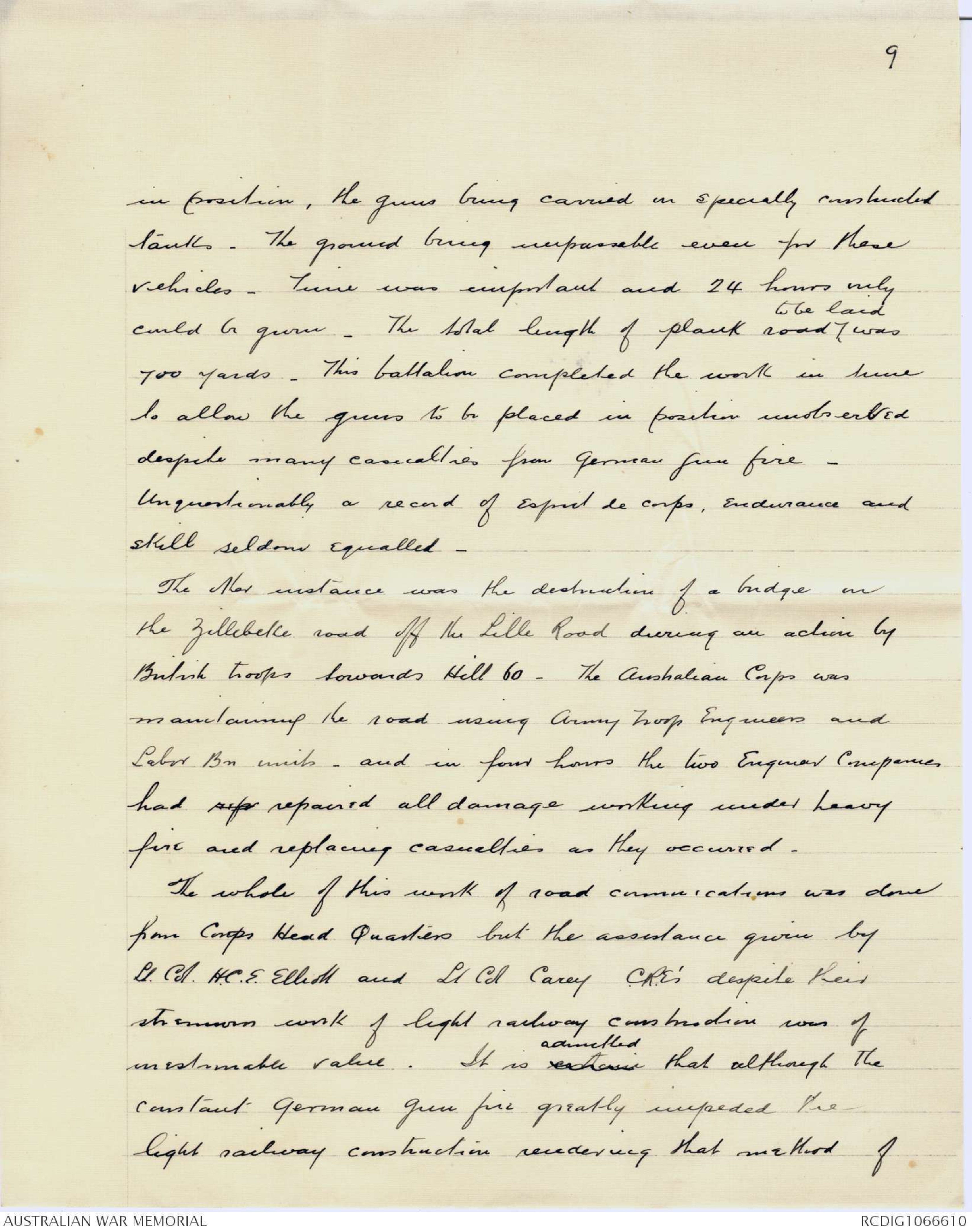
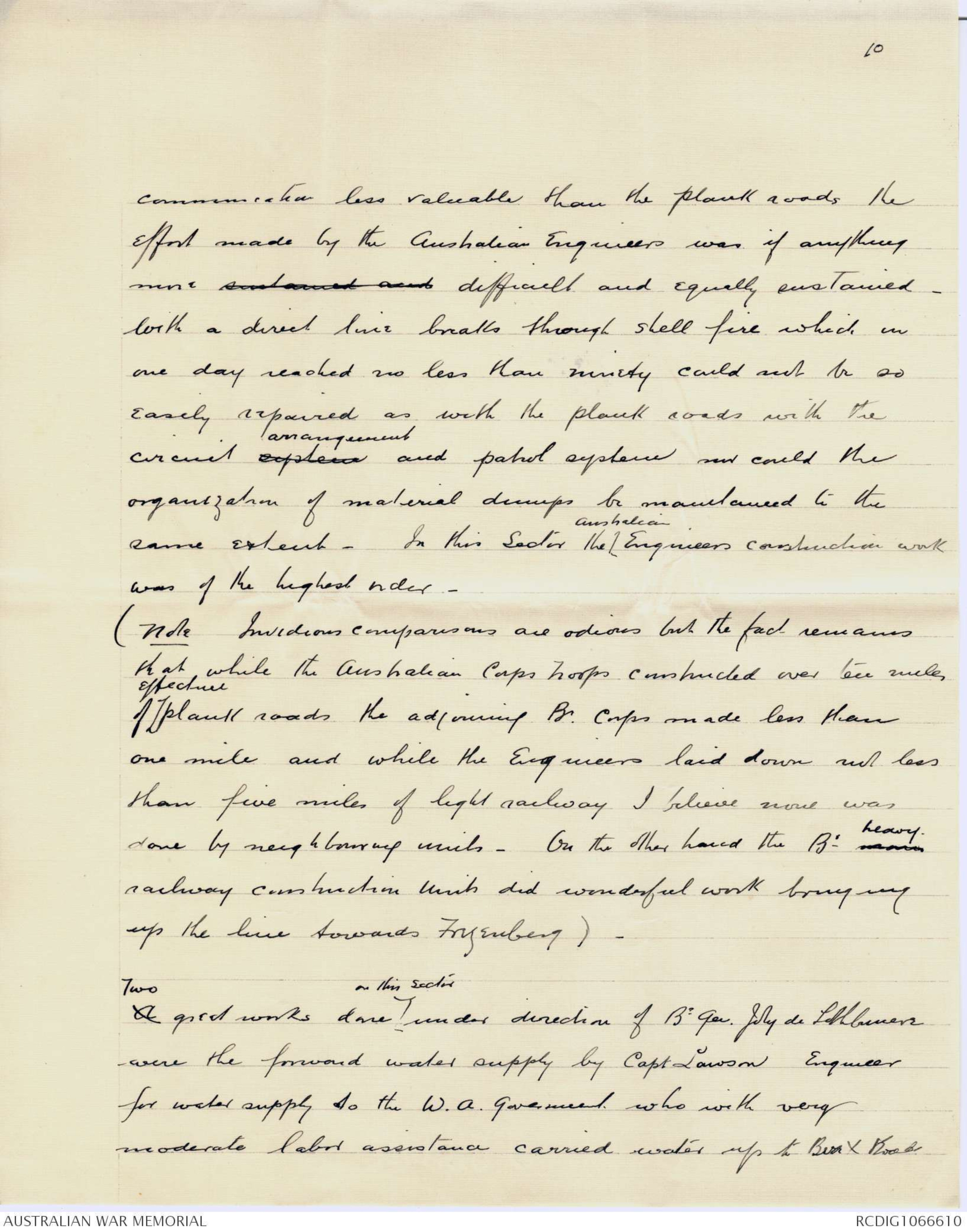

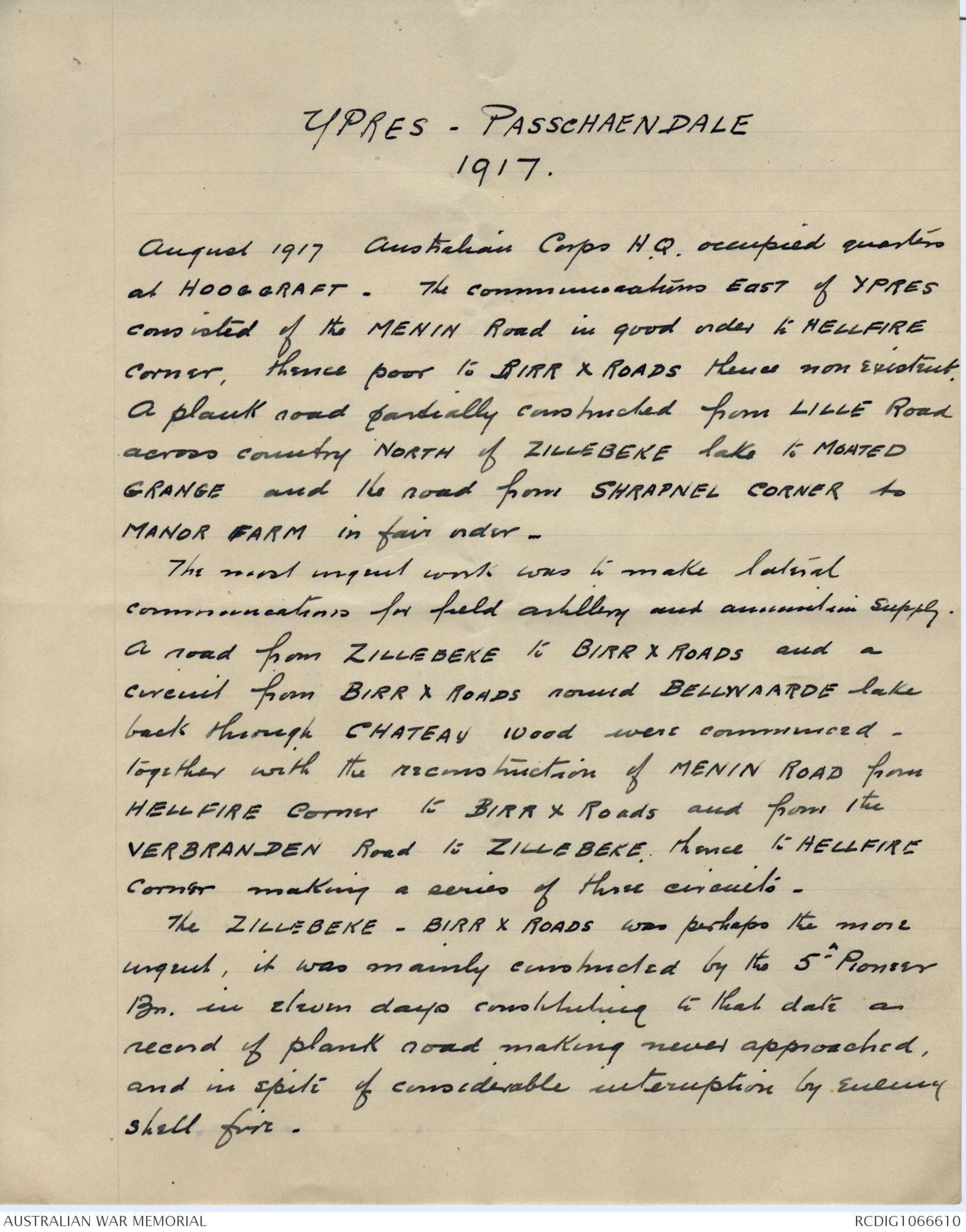
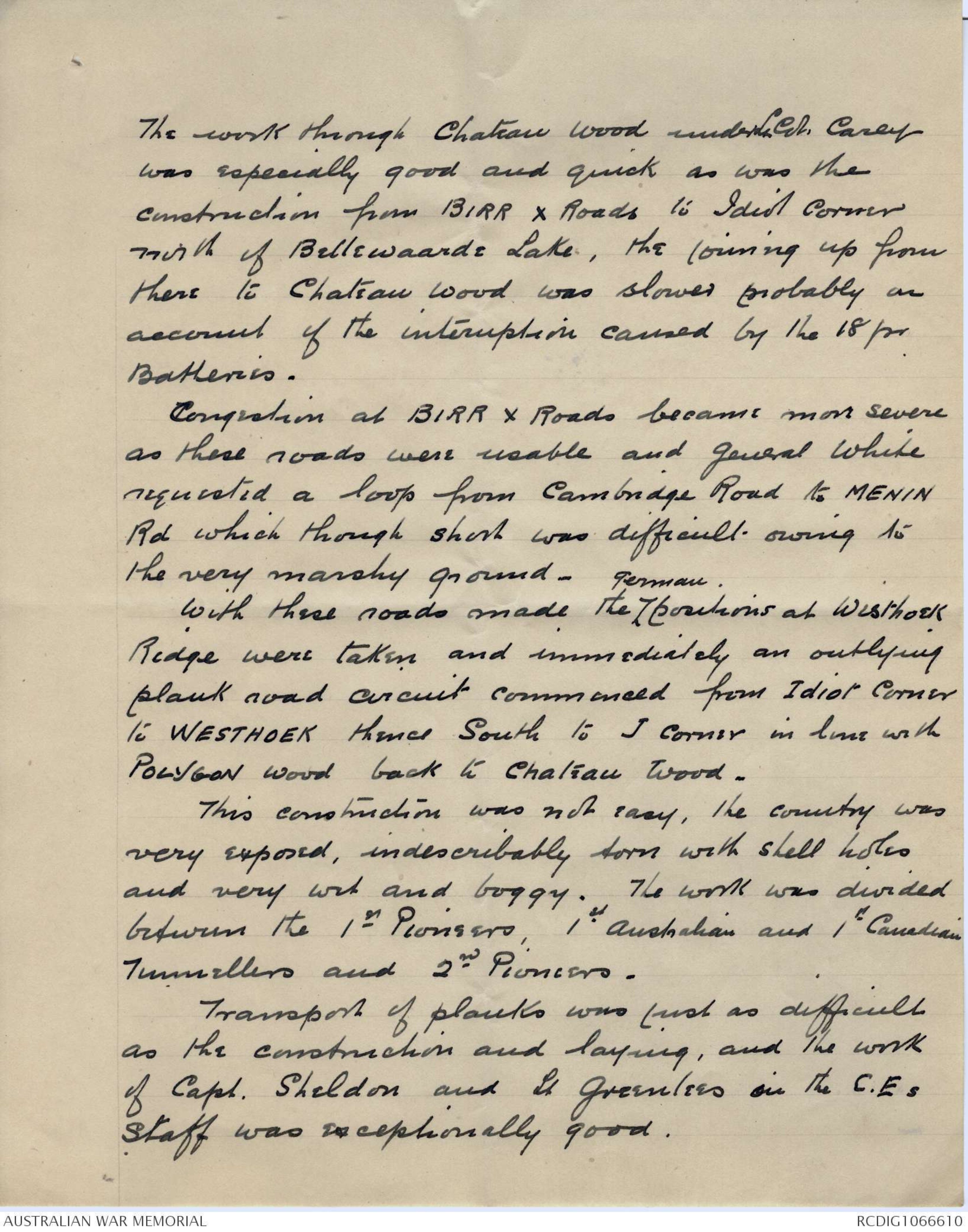
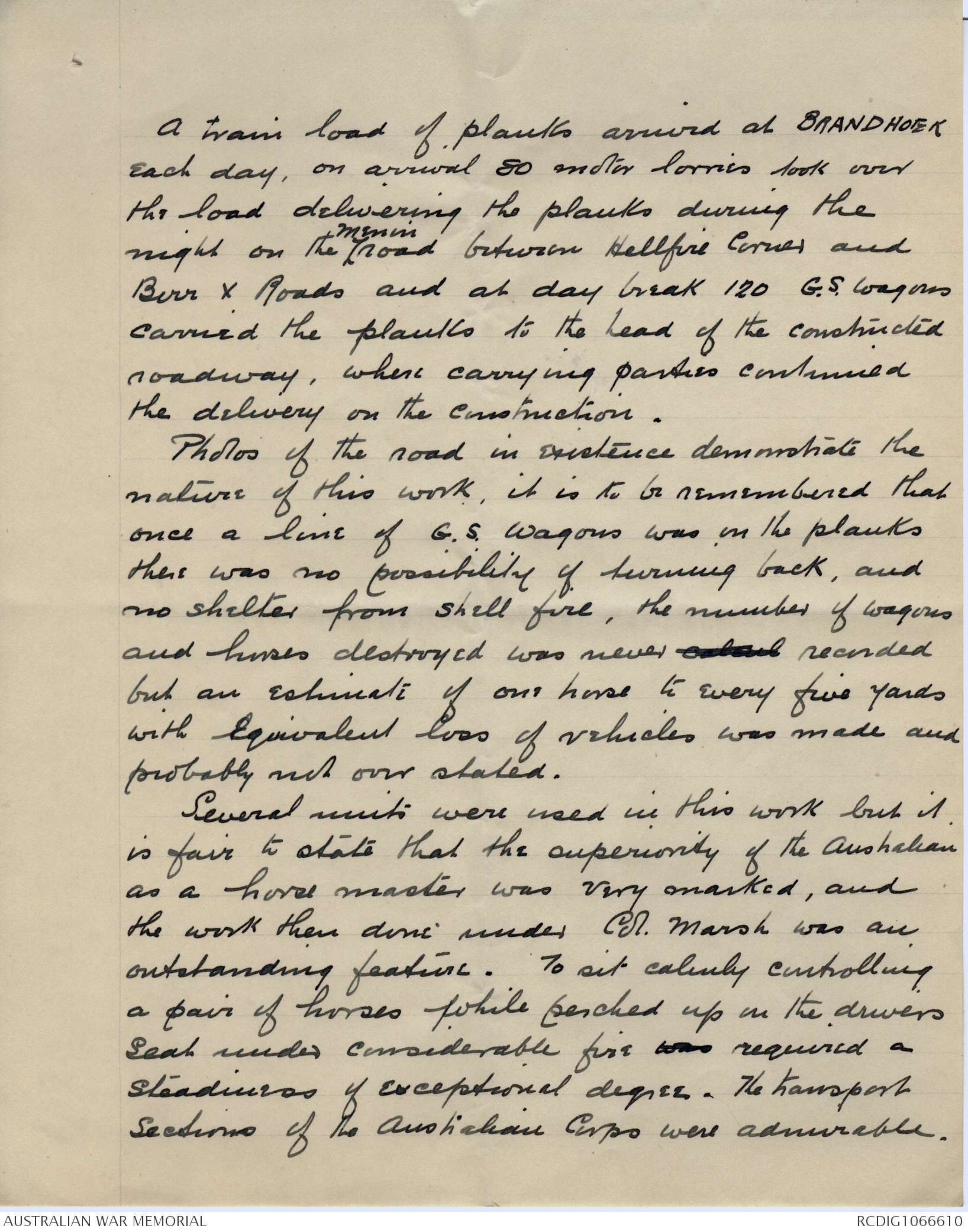
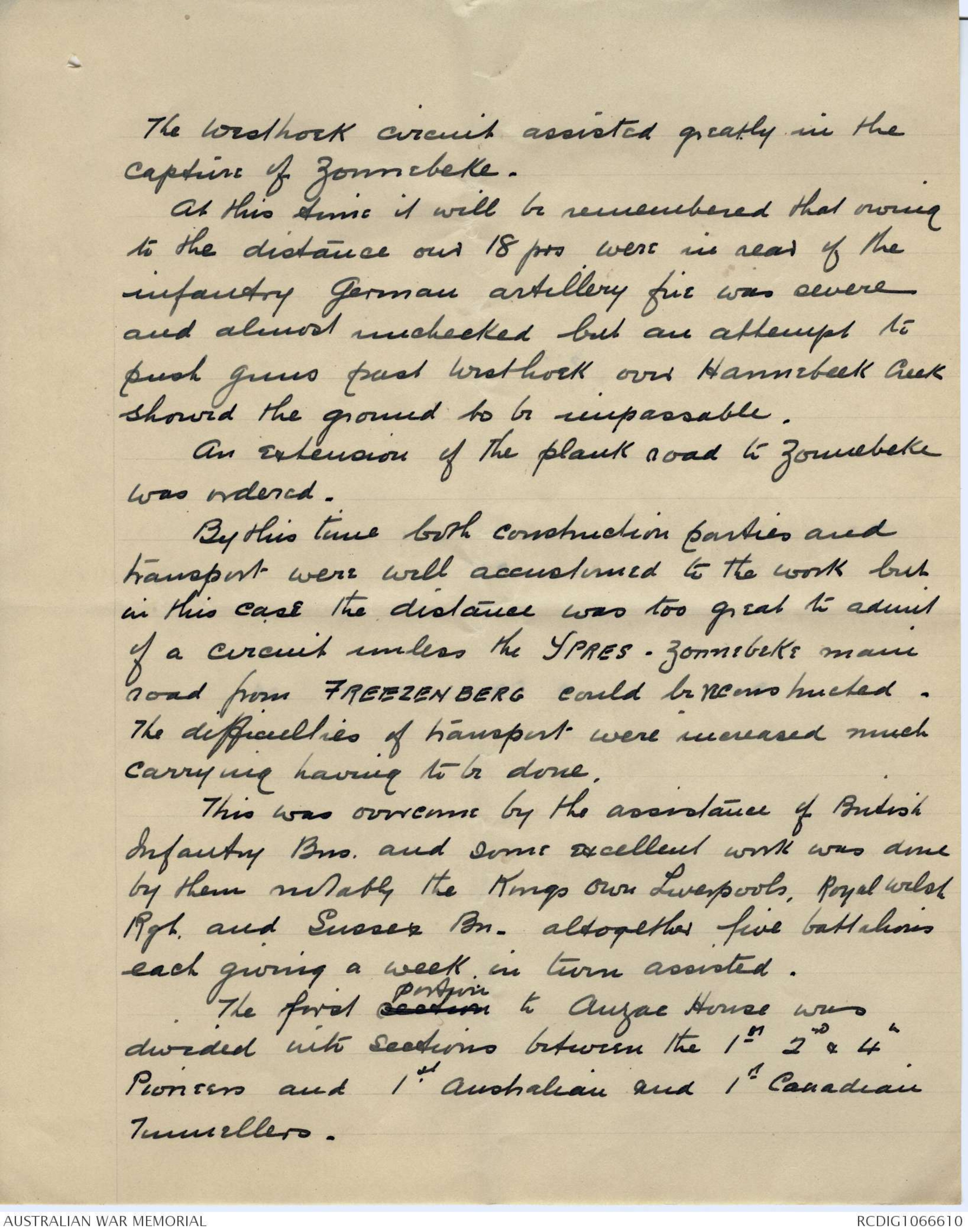

7
The arduous nature of the work of construction was equalled
in the constant effort required to maintain the roads.
Naturally they formed a symmetrical ribband across the
extraordinarily torn up country absolutely visible to German
airmen and were shelled with vigor - As many as
sixty breaks in 24 hours were made and tribute
must be given the English ^ Army Engineer Compnis Corp xxx labour battalions for their work
in maintaining ^almost continuous traffic.
There units for the most part were composed of men over
age or suffering from soldiers who had already served and been
incapacitated for active Infantry service. Their main function
was to complete construction of communications roughly forward
under action conditions by Australian Pioneers but under
direction from the exceptionally able ^ British Corps Troops, Engineer Company,
attached to the Australian Corps in this Sector. They carried out
a most hazardous operation with courage and ability despite
serious losses.
At an advanced station between Hell Fire Corner and Menin
Gate a large party was maintained, from these patrols
went out regularly & hung back the 24 hours traversing the
circuits in opposite directions making good any damage
done by enemy shell fire from material left in dumps
by the roadside.
8
On many occasions this damage was so great that
reinforcements had to be called upon from their camp
in rear of Ypres and or issorn those at times Australian
Pioneers after a heavy days work were sent out at night
to assist. Lt. Col Casey C.R.S. 5 Arm. Div. (M): Lt Dainty Field
Engineer to C.R.E. Corps Troops (Lt Col. Nicholson) was mainly
responsible for this important work and it is on record that
traffic was never stopped for more than three hours on
any occasion. Lt Dainty was killed during this work
between Westhoek Ridge and the Hanebeek.
The importance of the plank roads can be hardly over
estimated. Owing to the disturbed condition of the area it
was impossible to move artillery or bring up gun ammunition
until they were constructed and the times and dates of
operations depended greatly upon the times when these
roads could be completed. It may be fairly claimed that
in no case was the date given by Br Gen. Jolly de Lotbiniere
Chief Engineer for the Aust. Corps ever exceeded -
Where all did such notable work it is hardly fair to
single out special instances but the work done by the
1st Pioneers at Hooge ^ under Lt Col Murdoch and two companies of Corps Troops Engineers
under Capt Kemp and Capt Owen stand out as spectacular.
At Hooge it was necessary to place a 9" battery
9
in position, the guns being carried in specially constructed
tanks. The ground being impassable even for these
vehicles. Time was important and 24 hours only
could be given. The total length of plank road ^to be laid was
700 yards. This battalion completed the work in time
to allow the guns to be placed in position unobserved
despite many casualties from German gun fire.
Unquestionably a record of esprit de corps, endurance and
skill seldom equalled.
The other instance was the destruction of a bridge on
the Zillebeke road off the Lille Road during an action by
British Troops towards Hill 60. The Australian Corps was
maintaining the road using Army Troop Engineers and
Labour Bn units - and in four hours the two Engineer Companies
had ref repaired all damage working under heavy
fire and replacing casualties as they occurred.
The whole of this work of road communications was done
from Corps Head Quarters but the assistance given by
Lt. Co. H.C.E. Elliott and Lt. Col Casey C.R.E's despite their
strenuous work of light railway constructions was of
inestimable value. It is xxxxx admitted that although the
constant German gun fire greatly impeded the
light railway construction rendering that method of
10
communication less valuable than the plank roads the
effort made by the Australian Engineers was if anything
more sustained and difficult and equally sustained -
with a direct line breaks through shell fire which in
one day reached no less than ninety could not be so
easily repaired as with the plank roads with the
circuit explai arrangement and petrol system nor could the
organization of material dumps be maintained to the
same extent. In this Section the ^Australian Engineers construction work
was of the highest order.
(Note Invidious comparisons are odious but the fact remains
that while the Australian Corps Troops constructed over ten miles
of ^effective plank roads the adjoining Br. Corps made less than
one mile and while the Engineers laid down not less
than five miles of light railway I believe none was
done by neighbouring units. On the other hand the Bn xxxx heavy
railway construction Units did wonderful work bringing
up the line towards Fryenberg).A Two great works done ^in this sector under direction of Br. Gen. Jolly de Lotbiniere
were the forward water supply by Capt Lawson Engineer
for water supply to the W.A Government who with very
moderate labour assistance carried water up to Birr X Road
11
from Dicklebusch and the badly needed hut accommmodation
organized by ^Major Sheldon and Capt Greenlees on plans drawn by Capt Keys -
The Nissen hut being unprovenable Capt Keys designed the Keys hut and mass construction under Greenlees
direction
unquestionably enabled several thousand Australians to
shelter otherwise xxxxx xxxxxxx unattainable.
[[*Capt. Keys afterwards Govt architect
shack settlements Singapore*]]
Notes.
1. Corps plans should be obtainable showing the roads made.
2. Gen. C.B.B. White would probably have a keen remembrance of
the roads as many were made on his direct request.
3. The incident of the 1st Aust. Pioneers making the road for the 9" guns
would be recalled by Genl White. It happened Lobo skipped in
passing on orders leaving the line so short.
4. Major Coleman (Secy Air Force) and Co. W. Smith A.P.M. both
knew a good deal about Menin Road.
5. Genl. Glascow knew of the road from Westhoek to Zonnebeke.
6. Col. Martyn could give most detail about the light railway.
I had nothing to do with that.
7. Capt Greenlees would know all about the transport, so would
Col. Marsh.
8. Major Donnelly 5th Pioneers ought be worth consulting for confirmation.
YPRES - PASSCHAENDALE
1917
August 1917 Australian Corps H.Q. occupied quarters
at HOOGGRAFT. The communications East of YPRES
consisted of the MENIN Road in good order to HELLFIRE
Corner, thence poor to BIRR X ROADS thence non existent.
A plank road partially constructed from LILLE Road
across country NORTH of ZILLEBEKE lake to MOATED
GRANGE and the road from SHRAPNEL CORNER to
MANOR FARM in fair order.
The most urgent work was to make lateral
communications for field artillery and ammunition supply.
A road from ZILLEBEKE to BIRR X ROADS and a
circuit from BIRR X ROADS round BELLEWAARDE lake
back through CHATEAU Wood were commenced -
together with the reconstruction of MENIN ROAD from
HELLFIRE Corner to BIRR X ROADS and from the
VERBRANDEN Road to ZILLEBEKE thence to HELLFIRE
corner making a series of three circuits.
The ZILLEBEKE - BIRR X ROADS was perhaps the more
urgent, it was mainly constructed by the 5th Pioneer
Bn. in eleven days constructing to that date as
record of plank road making never approached,
and in spite of considerable interuption by enemy
shell fire.
The work through Chateau Wood under Lt. Col Casey
was especially good and quick as was the
construction from BIRR X Roads to Idiot Corner
north of Bellewaarde Lake. The joining up from
there to Chateau Wood was slower probably an
account of the interuption caused by the 18 pdr
Batteries.
Congestion at BIRR X Roads became more severe
as these road were usable and General White
requested a loop from Cambridge Road to MENIN
Rd which though short was difficult owing to
the very marshy grounds.
With these roads made the ^German position at
Westhoek
Ridge were taken and immediately an outlying
plank road circuit commenced from IDIOT Corner
to WESTHOEK thence south to J Corner in line with
POLYGON Wood back to Chateau Wood.
This construction was not easy, the country was
very exposed, indescribably torn with shell holes
and very wet and boggy. The work was divided
between the 1st Pioneers, 1st Australian and 1st Canadian
Tunnellers and 2nd Pioneers.
Transport of planks was just as difficult
as the construction and laying, and the work
of Capt. Sheldon and Lt. Greenlees on the C.Es
Staff was exceptionally good.
A train load of planks arrived at BRANDHOEK
each day, on arrival 80 motor lorries took over
the load delivering the planks during the
night on the ^Menin Road between Hellfire Corner and
Birr X Roads and at day break 120 G.S. wagons
carried the planks to the head of the constructed
roadway, where carrying parties continued
the delivery on the construction.
Photos of the road in existence demonstrate the
nature of this work, it is to be remembered that
once a line of G.S. wagons was on the planks
there was no possibility of turning back, and
no shelter from shell fire, the number of wagons
and horses destroyed was never xxxx recorded
but an estimate of one horse to every five yards
with equivalent loss of vehicles was made and
probably not over stated.
Several units were used in this work but it
is fair to state that the superiority of the Australian
as a horse master was very marked, and
the work there done under Col. Marsh was an
outstanding feature. To site calmly controlling
a pair of horses which perched up on the drivers
seat under considerable fire was required a
steadiness of exceptional degree. The transport
sections of the Australian Corps was admirable.
The Westhoek circuit assisted greatly in the
capture of Zonnebeke.
At this time it will be remembered that owing
to the distance our 18 prs were in rear of the
infantry German artillery fire was severe
and almost unchecked but an attempt to
push guns post Westhoek over Hannebeek Creek
showed the ground to be impassable.
An extension of the plank road to Zonnebeke
was ordered.
By this time both construction parties and
transport were well accustomed to the work but
in this case the distance was too great to advise
of a circuit unless the YPRES-ZONNEBEKE main
road from FREEZENBERG could be reconstructed.
The difficulties of transport were increased much
carrying having to be done.
This was overcome by the assistance of British
Infantry Bns. and some excellent work was done
by them notably the Kings own Liverpools, Royal Welsh
Rgt and Sussex Bn. altogether five battalions
each giving a week in turn assisted.
The first section portion to Anzac House was
divided into sections between the 1st 2nd & 4th
Pioneers and 1st Australian and 1st Canadian
Tunnellers.
The valley of the Hanebeek was practically
a marsh swamp, and in draining the roadway
several 18 pr field guns were secured after being
practically submerged. Several considerable lengths
of the road were constructed on a foundation of
[[*facines*]] faggots their being no holding ground.
As soon as the 18 prs had been moved into
position construction work was hampered by the
mule [[hai?succession ?]]. in supply, drivers naturally
using construction ways to get up to the guns
but such was the spirit of comradeship that though
it meant much added labor no complaint was
every sent it.
By the time the road was complete to Anzac
House there was a length of plank roads of over
six miles in constant use and the work of
maintenance was increasingly arduous, the
German communiques had communicated on the way
they apparently sprung up and they made great
efforts to destroy these. As many as forty shell
hits each time smashing planking and
at times of considerable extent occurred in a
day. Regular patrols were maintained day
and night, dumps of planks arranged and
special working parties held.
This work was entirely in charge of those
 Sam scott
Sam scottThis transcription item is now locked to you for editing. To release the lock either Save your changes or Cancel.
This lock will be automatically released after 60 minutes of inactivity.